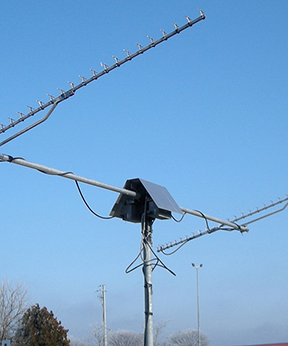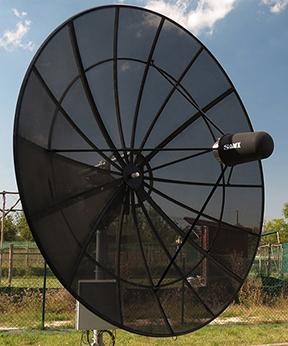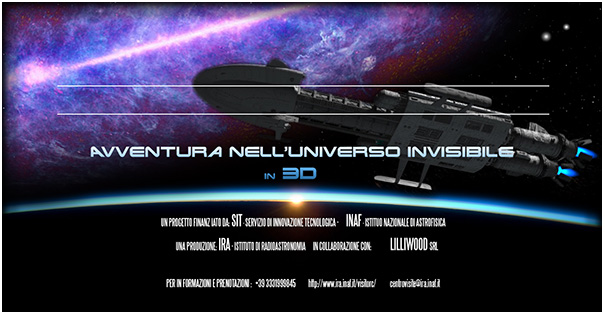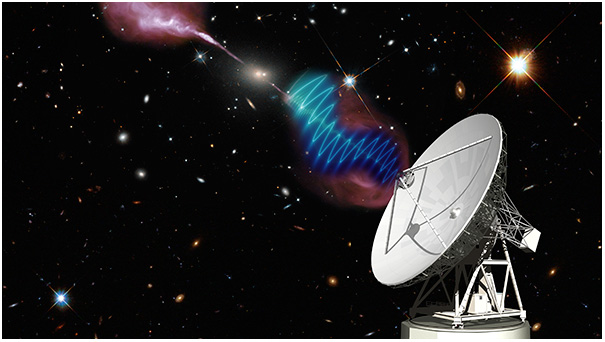Welcome to the Visitor Centre
"Marcello Ceccarelli".
PLEASE NOTICE: the actual possibility to open
to the public depends on national and regional regulations, in
turn varying according to the evolution of the COVID-19
emergency. Please contact us to receive info on the current
situation - the details given below might not be valid.
Many people see the large antennas of Medicina
even from a considerable distance, wondering what they are and
what these strange instruments do. Not everyone knows that they
are radio telescopes dedicated to professional astronomical
research, and many are not aware of the opportunity to visit
them. The Visitor Centre is addressed to the general public and
schools, offering unusual contents. Under the researchers’
guidance, visitors are accompanied through the discovery of
radio astronomy and the instruments it exploits, receiving
information on the research projects currently active in Italy.
NOTA: the Centre is
unfortunately not accessible to visitors with major motor
disabilities. An elevator is planned to be installed in early
2021.
General info on guided tours and calendar.
Telephone number and e-mail address to book your guided
tour.
Required booking procedures.
How to take part in a guided tour.
Guided Tours
The
structure has an expositive hall with exhibitions, interactive
experiences and historical instrumentation; it also hosts
a 98 seats multimedia room. The guided tour, both for schools and
for the public,
is available by following the appropriate booking procedures,
in the days and manners indicated in the schedule below. The
tour includes a "lesson" in the media room, including a 3D
projection, a tour of the exhibition full of interactive exhibits and
historical material, as well as the admission
to the adjacent radio-astronomical station
to observe the antennas closely.
THE VISITOR CENTRE IS
CLOSED IN JANUARY, JULY AND AUGUST, AND DURING THE CHRISTMAS AND
EASTER BREAKS.
For groups exceeding 20 participants, booking is
mandatory even on Sundays.
-
-
-
- Schools
(booking is required)
- Weekdays
- starting
at 9:30
-
-
-
- Groups
(booking is required)
- Saturday
- timing to
be agreed
-
-
-
- General
Pubblic
(no booking)
- Sunday
- starting
at 15:00
Contacts and Booking
For information and booking please contact
centrovisite
@ira.inaf.it
NOTA: the Centre is
unfortunately not accessible to visitors with major motor
disabilities. An elevator is planned to be installed in early
2021.
How to visit us
Individuals and small groups visiting on
Sundays - during the Centre operative season - do not need to
book. We recommend visitors to arrive on time: in
case of late arrivals they will not be able to make up for the
missed parts of the tour.
When booking is necessary, visitors are required
to contact us via e-mail or calling
the dedicate number, in order to receive the
proper booking form - which then must be filled-in and returned.
For groups exceeding 20
participants, booking is mandatory even on Sundays.
ADMISSION FEE € 5,00 (free for children under
12, when accompanied).
The fee includes the 3D glasses for the vision of a short movie.
THE VISITOR CENTRE IS CLOSED IN JANUARY, JULY, AUGUST AND DURING
THE CHRISTMAS AND EASTER BREAKS.
Staff and collaborators
| Responsible and Curator of
the Exhibition and Activities |
Stefania Varano |
Local referent
|
Simona Righini
|
Education and multimedia contents
|
Jader Monari, Roberto Ricci, Simona Righini,
Stefania Varano, Alessandra Zanichelli |
| Website and technology coordination |
Marco Poloni |
Technical support
|
Germano Bianchi, Claudio Bortolotti, Alessandro
Cattani, Marco Poloni, Juri Roda, Mauro Roma, Marco
Schiaffino, Matteo Stagni, Franco Tinarelli, Marco
Tugnoli |
Administrative support
|
Mauro Nanni, Maria Rezzaghi, Simona Righini |
Tour Guides
|
Luca Angeretti, Germano Bianchi, Marisa Brienza,
Massimo Cau, Federico Di Giacomo, Marcello Giroletti,
Daria Guidetti, Jader Monari, Roberto Orosei, Marco
Poloni, Giacomo Principe, Giuseppe Pupillo, Roberto
Ricci, Simona Righini, Ilaria Ruffa, Carlo
Stanghellini, Chiara Stuardi, Beatrice Terni De
Gregory, Stefania Varano, Alessandra Zanichelli |
Exhibition
|
|
| Layout |
Studio Andrea
Fantini
|
| Graphics |
Silvana
Vialli
|
Contents of multimedia panels
|
Roberto Ambrosini, Jan Brand, Claudio Bortolotti,
Viviana Casasola, Rossella Cassano, Luigina Feretti,
Andrea Giannetti, Marcello Giroletti, Daria Guidetti,
Elisabetta Liuzzo, Nuria Marcelino, Marcella Massardi,
Arturo Mignano, Jader Monari, Giovanni Naldi, Mauro
Nanni, Monia Negusini, Alessandro Orfei, Andrea
Orlati, Rosita Paladino, Stefano Parisini, Federico
Perini, Marco Poloni, Isabella Prandoni, Simona
Righini, Mauro Roma, Pierguido Sarti, Carlo
Stanghellini, Stefania Varano, Tiziana Venturi,
Alessandra Zanichelli |
Design and production of interactive
exhibits
|
Marco Bartolini, Claudio Bortolotti, Adelmo
Eliogabili, Andrea Fantini, Franco Fiocchi, Jader
Monari, Mauro Nanni, Marco Poloni, Roberto Ricci,
Simona Righini, Juri Roda, Mauro Roma, Marco
Schiaffino, Franco Tinarelli, Goliardo Tomassetti,
Marco Tugnoli, Stefania Varano, Alessandra Zanichelli |
Collaborations
3D short movies
"Avventura nell'Universo Invisibile"
"Avventura nell'Universo Invisibile": this
short movie, particularly suitable for children, narrates an
imaginary travel across the Solar System and beyond. Viewers
can identify themselves with the main character, an astronaut,
who is in charge of saving the Earth from an incoming asteroid
and faces a peculiar adventure... This movie includes some of
the scientific and technic contents presented during the tour.
The 2D trailer can be watched here:
"Avventura - the trailer".
"Come Funziona: La Radioastronomia"
"Come Funziona: La Radioastronomia": this 3D
short documentary accompanies the spectators along the whole
path that characterises a radio-astronomical observation.
Starting from the radio waves emission by part of the faraway
celestial sources, it narrates how such observations are
performed and how the astronomers lead their research
activities, ending up in the production of scientific papers.
During this travel, spectators virtually visit the radio
telescope, the laboratories and different environments where
researchers work. The 2D trailer can be watched here:
"Come funziona - the
trailer".
Guided Tours for Secondary Schools
The guided tour is composed by three parts:
- Introduction (lesson)
- Visit to the exhibition
- Visit to the radio telescopes
Some advanced hands-on laboratories are available, for dedicated
visits:
"Interferometry Lab"
and
"SmaRT - Educational radio
telescope".
INTRODUCTION
A 45-minute lesson to illustrate Radioastronomy basics:
students are provided with information on the involved science
and technology, and on the main ongoing research/development
projects.
This overview touches different topics, such as:
- The electromagnetic spectrum
- Radio Emission Mechanisms
- Multi-band observations of the Universe
- The radio band: sources and radio-optical comparisons
- A brief history of Radioastronomy
- Radio telescopes: main features
- Radio telescopes around the world
- The antennas of the Medicina Radio Astronomical Station
- Research Projects: astronomical e geodynamic VLBI,
spectrometry, polarimetry, etc...
The lesson contents can be "fine-tuned" according to the
teachers' specific needs.
VISIT TO THE EXHIBITION
The showroom contains explicative panels, examples of the
technologies employed in the Radio Astronomical Station along 50
years of activity and a set of multimedia and interactive
exhibits to deepen the topics discussed during the lesson. The
visit to this section can be carried out either with or without
the guide, and its duration can be tailored to match the needs
of the group - yet respecting the overall constraints posed by
the Visitor Centre schedule.
VISIT TO THE RADIO TELESCOPES
Using the bus, students are moved to the radio telescope
station, where the instruments can be closely examined. This
visit lasts about 30 minutes. It takes place outdoor, even in
adverse weather conditions. It is not allowed to enter the
laboratories and offices, in order not to interfere with the
station staff at work.
Interferometry lab
Educational hands-on experience, for high school students

Interferometry is an essential technique of observation
and investigation for radio astronomy. Introducing this
science to students, it is important to talk about this method
of radio data acquisition.
The
interferometry lab is an educational hands-on activity
designed for students in the last years of high school (mainly
for a scientific-technological curriculum). The laboratory
includes the acquisition and analysis of real
radio-astronomical data, acquired with an interferometer
specifically designed for educational purposes.
Contact us for details.
SmaRT: Small Radio Telescope
Educational hands-on experience, for high school students

The
Haystack Observatory, a MIT interdisciplinary research center
(USA), has developed a small educational radio telescope
called "Small Radio Telescope" (in short SmaRT). It is able to
carry out radioastronomy observations in two different ways,
both at a frequency of about 1.42 GHz: "continuum" and
"spectral lines."
This device provides a good basis to introduce secondary
school students and amateur astronomers to the radioastronomy
field. Such a radio telescope is an effective educational
tool, as it involves multiple disciplines: astronomy, digital
signal processing, software development and data analysis.
Contact us for details.
Guided Tours for Children
For children between 6 and 12 years (primary
schools) the tours include, besides an introductory lesson
suitable for students in the mentioned range of age, some
dedicated activities. For example there is the "Hunting"
for radio waves experiment, which challenges
the children in the hands-on understanding of how radio waves
interact with different materials and obstacles, and the
interactive exhibit The color
machine, allowing the visitors to discover the
many ways in which electromagnetic waves are involved in our
daily lives.
For smaller children, between 3 and 6 years of age, a new
activity is being developed: "You
can't see it, but it's there".
"Hunting" for radio waves
Hands-on educational activity for primary school students
Explicitly introducing the radioastronomical
technologies and observing methods can be extremely
challenging. Especially when addressing children. This
laboratory, exploiting their direct experience, helps the
children to discover what the radio telescopes are used for,
ans how they allow us to study the Universe.
It is mainly conceived for primary school children.
Participants are invited to personally study the interaction
between radio waves and different materials and obstacles,
whose surfaces show different accuracies. la cui
superficie presenta diverse accuratezze. While "hunting" for
radio waves, children learn the best way to collect and
"catch" them.
During the experiment, children are first led to observe that
radio waves, though invisible to our eyes, are detectable with
an antenna that is sensitive to this type of radiation, and
can become "visible" to us by means of a proper detector
connected to the antenna. Then, they have to identify -
through a series of "trial and error" opeations - the right
obstacle to be interposed between the transmitter and the
receiver, in order to block the radio waves and "catch" them.
This way, children discover by themselves which are the best
material and surfaces to build a radio telescope.
The color machine
Educational interactive exhibit for primary school students
In our daily lives we are surrounded by
radiation, from radio waves to gamma rays, yet it can be
observed and measured only with special instruments. This
experience helps to imagine how the sky and the world around
us would look if our sight was not limited to the visible
light but was extended to all the frequencies of the
electromagnetic spectrum. The center knob allows you to tune
the frequency as in an old radio. Turning the knob clockwise
you will move toward the higher frequencies (gamma rays),
counterclockwise you will go toward the lower frequencies
(radio waves). The screen will show the objects and phenomena
that become visible at the selected frequency. During the
guided tours for children, the focus is on the observation of
"the room": this is a painting showing the interior of a
house, on which the objects that emit a particular kind of
wave are represented, for all the frequency bands of the
electromagnetic spectrum. This makes it possible to introduce
and explore the concept of "invisible information", which is
constantly present around us.
You can't see it, but it's there!
Hands-on educational activity for young children (aged 3-6)
Preschoolers are not able to build a complex
cognitive structure in which the role of a radiotelescope - a
telescope able to "see something that is invisible" - can find
place.
"You can't see it, but it's there!" is a laboratory addressing
children between 3 and 6. It is based on the discovery of the
senses as means that convey information about the world
surrounding us.
Guided Tours for the General Public
The Visitor Centre opens every Sunday (see
exceptions listed below) at 15:00. No booking is required,
unless you have organised a group of 20 participants or more. We
recommend visitors to arrive on time: in case of
late arrivals they will not be able to make up for the missed
parts of the tour.
The tour lasts about 2 hours. It is divided in three phases: an
introductive overview on Radioastronomy (including the 3D
projection of a short movie), the visit to the interactive and
historical exhibition and a guided walk between the
radiotelescopes of the Medicina station.
ADMISSION FEE € 5,00 (free for children
under 12, when accompanied).
The fee includes the 3D glasses for the vision
of a short movie.
THE VISITOR CENTRE IS CLOSED IN JULY AND AUGUST, AND DURING
THE CHRISTMAS AND EASTER BREAKS. SUNDAY TOURS MIGHT BE
SUPPRESSED IN JANUARY, contact us for details.
The building hosting the Visitor Centre also
hosts a renowned restaurant:
Ristorante
La Sosta dei Sapori - S’apposentu. It
offers special discounts for schools and large groups, yet only if
booking and arranging details in advance. For information and
booking, please directly contact the restaurant.
Authorisation for photo-video shootings
How to request an authoristion for the
production of videos, photos and recordings
The Institute of Radioastronomy often welcomes photographers,
journalists, or other persons (professionals or amateurs)
needing to record images or videos for different uses. Anyone
wishing to access our observatory or the Visitor Center for
these activities is required to contact us in advance.
Proper regulations and forms will be sent to these enquirers,
who will be also asked to provide details on the usage of the
iconographic material they plan to produce.
If interested, please contact us at
centrovisite
@ira.inaf.it
PLEASE NOTICE: ACCESS TO THE STATION WILL BE GRANTED
ONLY TO THOSE POSSESSING A PROPERLY SIGNED AUTHORISATION
EMITTED BY INAF-IRA.
The Visitor Centre "Marcello Ceccarelli"
was opened and developed thanks to ()






 Lat. Nord
44°31'36.9" Long. Est 11°37'34.7" - Elevaz. 28m
Lat. Nord
44°31'36.9" Long. Est 11°37'34.7" - Elevaz. 28m 







